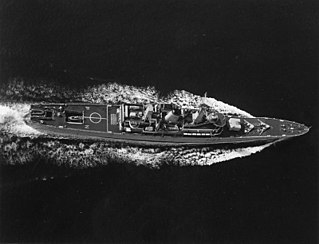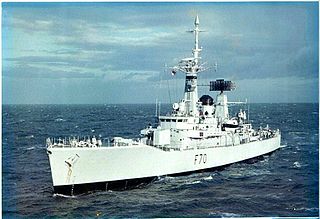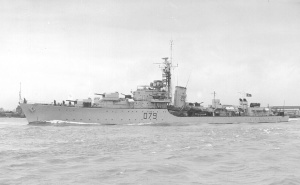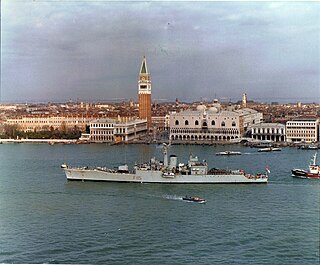
HMS Amazon was the first Type 21 frigate of the Royal Navy. Her keel was laid down at the Vosper Thornycroft shipyard in Southampton, England. The ship suffered a fire in the Far East in 1977, drawing attention to the risk of building warships with aluminium superstructure.

HMS Glamorgan was a County-class destroyer of the Royal Navy with a displacement of 5,440 tonnes. The ship was built by Vickers-Armstrongs in Newcastle Upon Tyne and named after the Welsh county of Glamorgan.

HMS Hampshire was a County-class destroyer of the Royal Navy. Laid down, in March 1959 a couple of weeks behind the class leader Devonshire, she was classified as a guided missile destroyer, as the Sea Lords regarded the concept of the cruiser and big gun ship as discredited by the perceived failure of the Tiger class and the obsolescence of the heavy gun. The description of guided missile destroyer seemed more likely to win approval from the Treasury and Government for an adequate number of warships the size of small cruisers, which could play many traditional cruiser flagship and command functions, but had no armour around its gun and missile magazine.

HMS Kent was a batch-1 County-class destroyer of the Royal Navy. She and her sisters were equipped with the Sea Slug Mk-1 medium-range surface-to-air missile SAM system, along with the short-range Sea Cat SAM, two twin 4.5-inch gun turrets, two single 20mm cannon, ASW torpedo tubes, and a platform and hangar that allowed her to operate one Wessex helicopter. The County class were large ships, with good seakeeping abilities and long range, and were ideal blue-water ships for their time.

HMS Bristol (D23) was a Type 82 destroyer, the only vessel of her class to be built for the Royal Navy. Bristol was intended to be the first of a class of large destroyers to escort the CVA-01 aircraft carriers projected to come into service in the early 1970s but the rest of the class and the CVA-01 carriers were cancelled as a result of the 1966 Defence White Paper which cut defence spending.

HMS Andromeda was a Leander-class frigate of the Royal Navy. She was built at HM Dockyard Portsmouth. She was launched on 24 May 1967 and commissioned into the Royal Navy on 2 December 1968. She took part in the Falklands War. She was sold to India in 1995, for use as a training ship, being renamed INS Krishna. She was finally decommissioned in May 2012.

HMS Penelope was a Leander-class frigate of the Royal Navy. In the Falklands War, Penelope fired on an Argentine patrol boat and claimed to be the last ship attacked by Argentine aircraft over the course of the war. In 1991, she was commissioned into the Ecuadorean Navy, and renamed Presidente Eloy Alfaro.

HMS Apollo was a batch 3B broadbeam Leander-class frigate of the Royal Navy. She was, like the rest of the class, named after a figure of mythology. Apollo was built by Yarrow Shipbuilders of Scotstoun. She was launched on 15 October 1970 and commissioned on 28 May 1972, making her the penultimate Leander.

HMS Cadiz was a Battle-class destroyer of the Royal Navy. She was named after the Battle of Cádiz, in which the French besieged the Spanish town in 1810, which was eventually lifted in 1812 after the French defeat at the Battle of Salamanca.

HMS Yarmouth was the first modified Type 12 frigate of the Rothesay class to enter service with the Royal Navy.

The Type 41 or Leopard class were a class of anti-aircraft defence frigates built for the Royal Navy and Indian Navy in the 1950s. The Type 41, together with the Type 61 variant introduced diesel propulsion into the Royal Navy, the perceived benefits being long range, low fuel use, reduced crew, and reduced complexity.

The Type 61 Salisbury class was a class of the Royal Navy aircraft direction (AD) frigate, built in the 1950s. The purpose of the aircraft direction ships was to provide radar picket duties at some distance from a carrier task force and offer interception guidance to aircraft operating in their area.

BAPFerré(DM-74) was a Daring-class destroyer in service with the Peruvian Navy from 1973 to 2007. She was built by Yarrow Shipbuilders and completed for the Royal Navy in 1953 as HMS Decoy (D106).

The Rothesay class, or Type 12M frigates were a class of frigates serving with the Royal Navy, South African Navy and the Royal New Zealand Navy.

HMS Rothesay was the lead ship of the Rothesay or Type 12M class of anti-submarine frigates of the British Royal Navy. She was commissioned in 1960 and scrapped in 1988.

HMS Lowestoft was a Rothesay-class or Type 12 class anti-submarine frigate of the British Royal Navy. Lowestoft was reconstructed in the late 1960s to largely the same pattern as the third group of Leander-class frigates, with new radar and fire control and a hangar and pad for a Westland Wasp helicopter for longer range, anti-submarine, engagement. In the late 1970s it was converted as the prototype towed array frigate for the Royal Navy, but retained its full armament. Lowestoft was sunk as a target on 8 June 1986 by HMS Conqueror using a Tigerfish torpedo. She was the last Royal Naval target to be sunk still displaying her pennant number.

HMS Berwick was a Rothesay- or Type 12I-class anti-submarine frigate of the British Royal Navy. She was built by Harland & Wolff and launched on 15 December 1959.

HMS Salisbury was a Salisbury-class or Type 61 aircraft direction frigate of the British Royal Navy. Completed in the late 1950s, Salisbury served through the 1960s and 1970s, participating in the Beira Patrol, blockading against Rhodesia and the confrontation with Iceland over fishing rights that was known as the Cod Wars. Salisbury became a harbour training ship in 1980, before being sunk as a target in 1985.

HMS Undaunted was a U-class destroyer of the British Royal Navy that saw service during World War II. She was later converted into a Type 15 fast anti-submarine frigate, with the new pennant number F53.
At least two ships of the Iranian Navy have been named Damavand:



















